Page 380 of 509
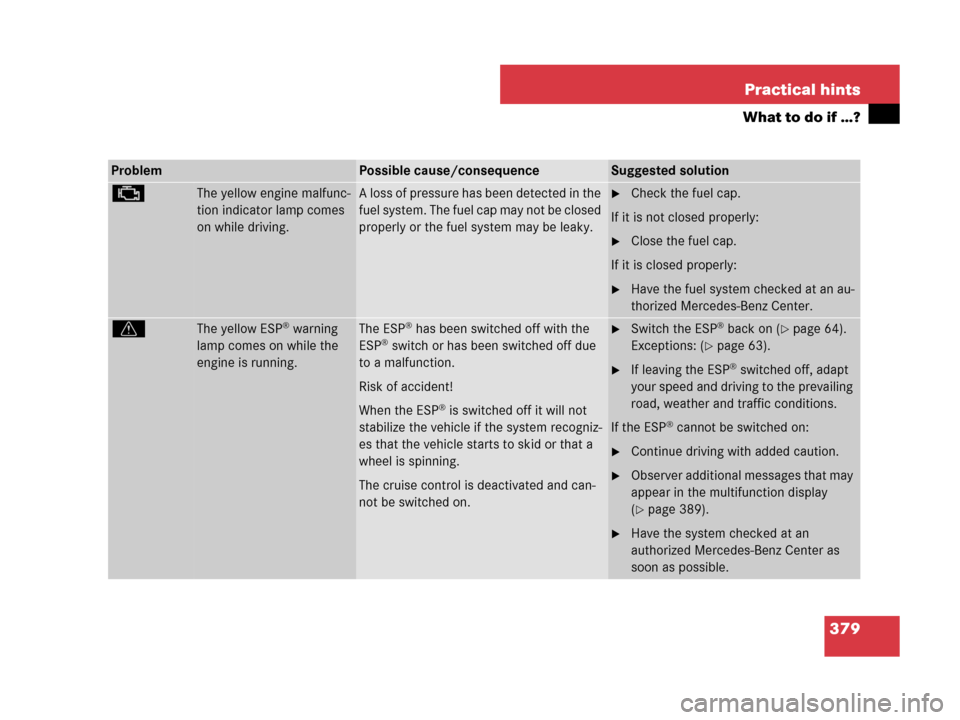
379 Practical hints
What to do if …?
ProblemPossible cause/consequenceSuggested solution
±The yellow engine malfunc-
tion indicator lamp comes
on while driving.A loss of pressure has been detected in the
fuel system. The fuel cap may not be closed
properly or the fuel system may be leaky.�Check the fuel cap.
If it is not closed properly:
�Close the fuel cap.
If it is closed properly:
�Have the fuel system checked at an au-
thorized Mercedes-Benz Center.
vThe yellow ESP® warning
lamp comes on while the
engine is running.The ESP® has been switched off with the
ESP® switch or has been switched off due
to a malfunction.
Risk of accident!
When the ESP
® is switched off it will not
stabilize the vehicle if the system recogniz-
es that the vehicle starts to skid or that a
wheel is spinning.
The cruise control is deactivated and can-
not be switched on.
�Switch the ESP® back on (�page 64).
Exceptions: (
�page 63).
�If leaving the ESP® switched off, adapt
your speed and driving to the prevailing
road, weather and traffic conditions.
If the ESP
® cannot be switched on:
�Continue driving with added caution.
�Observer additional messages that may
appear in the multifunction display
(
�page 389).
�Have the system checked at an
authorized Mercedes-Benz Center as
soon as possible.
Page 381 of 509
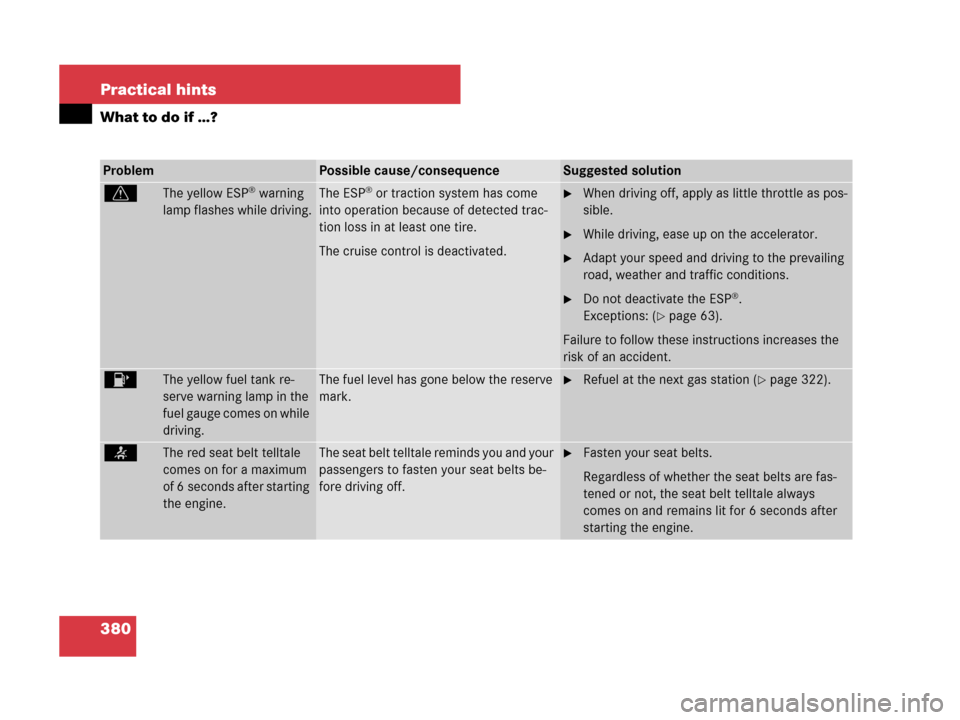
380 Practical hints
What to do if …?
ProblemPossible cause/consequenceSuggested solution
vThe yellow ESP® warning
lamp flashes while driving.The ESP® or traction system has come
into operation because of detected trac-
tion loss in at least one tire.
The cruise control is deactivated.�When driving off, apply as little throttle as pos-
sible.
�While driving, ease up on the accelerator.
�Adapt your speed and driving to the prevailing
road, weather and traffic conditions.
�Do not deactivate the ESP®.
Exceptions: (
�page 63).
Failure to follow these instructions increases the
risk of an accident.
4The yellow fuel tank re-
serve warning lamp in the
fuel gauge comes on while
driving.The fuel level has gone below the reserve
mark.�Refuel at the next gas station (�page 322).
comes on for a maximum
of 6 seconds after starting
the engine.The seat belt telltale reminds you and your
passengers to fasten your seat belts be-
fore driving off.�Fasten your seat belts.
Regardless of whether the seat belts are fas-
tened or not, the seat belt telltale always
comes on and remains lit for 6 seconds after
starting the engine.
Page 385 of 509
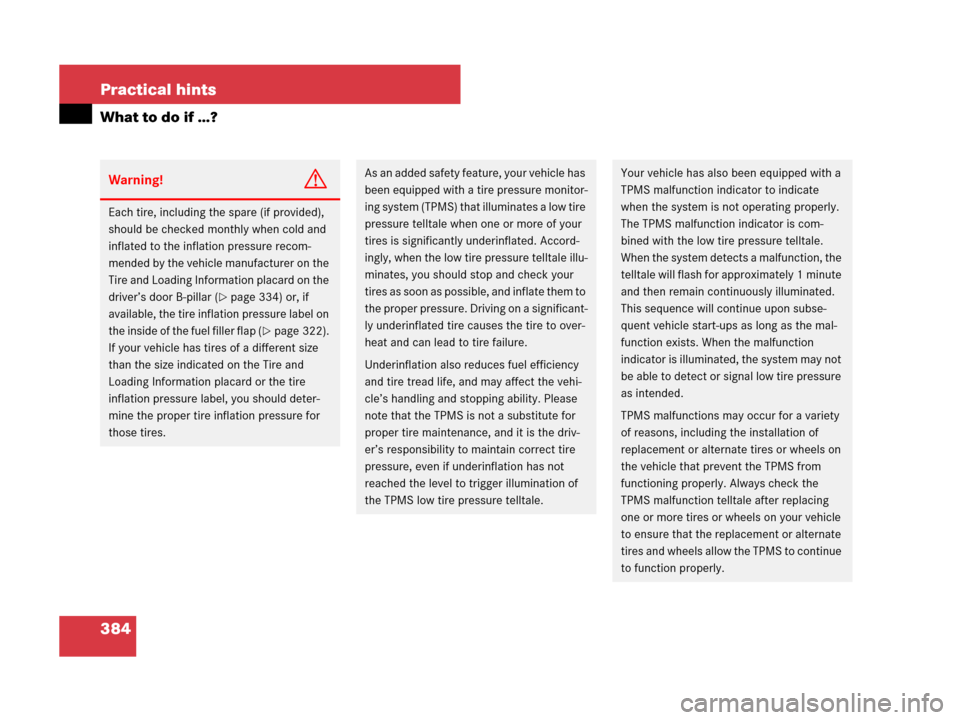
384 Practical hints
What to do if …?
Warning!G
Each tire, including the spare (if provided),
should be checked monthly when cold and
inflated to the inflation pressure recom-
mended by the vehicle manufacturer on the
Tire and Loading Information placard on the
driver’s door B-pillar (
�page 334) or, if
available, the tire inflation pressure label on
the inside of the fuel filler flap (
�page 322).
If your vehicle has tires of a different size
than the size indicated on the Tire and
Loading Information placard or the tire
inflation pressure label, you should deter-
mine the proper tire inflation pressure for
those tires.
As an added safety feature, your vehicle has
been equipped with a tire pressure monitor-
ing system (TPMS) that illuminates a low tire
pressure telltale when one or more of your
tires is significantly underinflated. Accord-
ingly, when the low tire pressure telltale illu-
minates, you should stop and check your
tires as soon as possible, and inflate them to
the proper pressure. Driving on a significant-
ly underinflated tire causes the tire to over-
heat and can lead to tire failure.
Underinflation also reduces fuel efficiency
and tire tread life, and may affect the vehi-
cle’s handling and stopping ability. Please
note that the TPMS is not a substitute for
proper tire maintenance, and it is the driv-
er’s responsibility to maintain correct tire
pressure, even if underinflation has not
reached the level to trigger illumination of
the TPMS low tire pressure telltale.Your vehicle has also been equipped with a
TPMS malfunction indicator to indicate
when the system is not operating properly.
The TPMS malfunction indicator is com-
bined with the low tire pressure telltale.
When the system detects a malfunction, the
telltale will flash for approximately 1 minute
and then remain continuously illuminated.
This sequence will continue upon subse-
quent vehicle start-ups as long as the mal-
function exists. When the malfunction
indicator is illuminated, the system may not
be able to detect or signal low tire pressure
as intended.
TPMS malfunctions may occur for a variety
of reasons, including the installation of
replacement or alternate tires or wheels on
the vehicle that prevent the TPMS from
functioning properly. Always check the
TPMS malfunction telltale after replacing
one or more tires or wheels on your vehicle
to ensure that the replacement or alternate
tires and wheels allow the TPMS to continue
to function properly.
Page 407 of 509
406 Practical hints
What to do if …?
Display Possible cause/consequencePossible solution
$You are driving with one or more doors
open.
The display symbol shows you which doors
are open.�Close the doors.
4Gas Cap LooseA loss of pressure has been detected in the
fuel system. The fuel cap may not be closed
properly or the fuel system may be leaky.�Check the fuel cap (�page 322).
If it is not closed properly:
�Close the fuel cap.
If it is closed properly:
�Have the fuel system checked at an autho-
rized Mercedes-Benz Center.
Reserve Fuel
LevelThe fuel level has gone below the reserve
mark.Refuel at the next gas station (�page 322).
YYou are driving with the hood open.�Stop your vehicle as soon as it is safe to do
so.
�Close the hood (�page 326).
There is otherwise danger of an accident.
Page 416 of 509
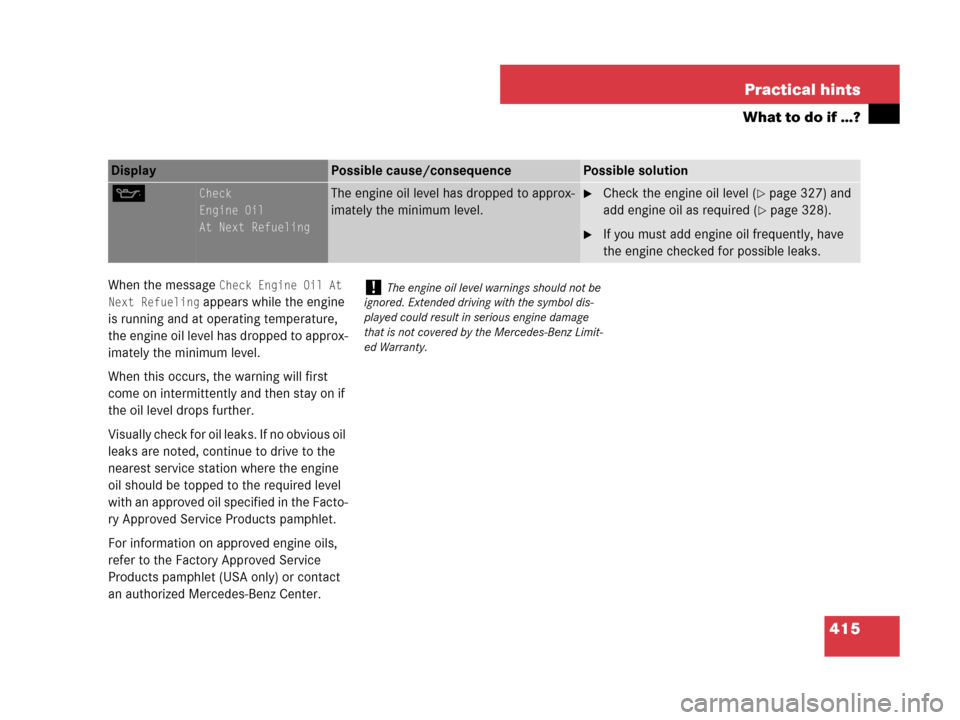
415 Practical hints
What to do if …?
When the message Check Engine Oil At
Next Refueling
appears while the engine
is running and at operating temperature,
the engine oil level has dropped to approx-
imately the minimum level.
When this occurs, the warning will first
come on intermittently and then stay on if
the oil level drops further.
Visually check for oil leaks. If no obvious oil
leaks are noted, continue to drive to the
nearest service station where the engine
oil should be topped to the required level
with an approved oil specified in the Facto-
ry Approved Service Products pamphlet.
For information on approved engine oils,
refer to the Factory Approved Service
Products pamphlet (USA only) or contact
an authorized Mercedes-Benz Center.
Display Possible cause/consequencePossible solution
ùCheck
Engine Oil
At Next RefuelingThe engine oil level has dropped to approx-
imately the minimum level.�Check the engine oil level (�page 327) and
add engine oil as required (
�page 328).
�If you must add engine oil frequently, have
the engine checked for possible leaks.
!The engine oil level warnings should not be
ignored. Extended driving with the symbol dis-
played could result in serious engine damage
that is not covered by the Mercedes-Benz Limit-
ed Warranty.
Page 427 of 509
426 Practical hints
Unlocking/locking in an emergency
Fuel filler flap
�Open the fuse box in the trunk
(
�page 458).
1Release cable
�Pull on the release cable1.
�Open the fuel filler flap.Manually unlocking the transmission
gear selector lever
In case of power failure, the transmission
gear selector lever can be manually un-
locked, e.g. to tow the vehicle.
1Selector lever cover
2Unlocking mechanism
�Apply the parking brake firmly.
�Push the selector lever cover1 to the
left and pull it up and off.
�Push the unlocking mechanism2
down and move the selector lever out
of positionP at the same time.The selector lever can now move freely
until reset to positionP.
iThis procedure does not arm the anti-theft
alarm system nor does it lock the fuel filler flap.
iThe gear selector lever is locked again when
moving it to positionP.
��
Page 452 of 509
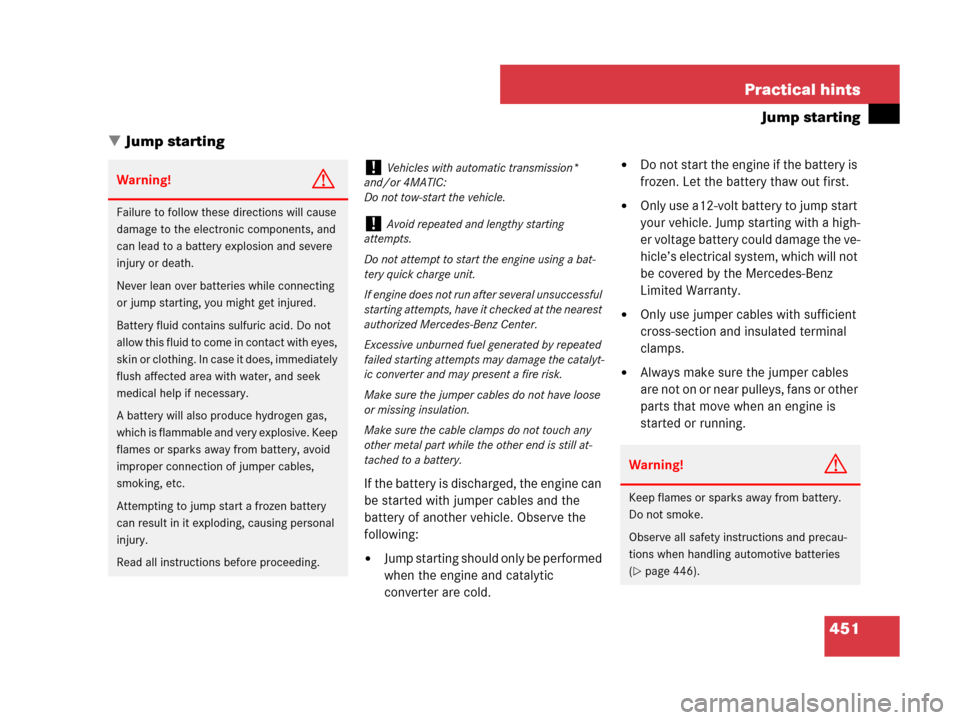
451 Practical hints
Jump starting
�Jump starting
If the battery is discharged, the engine can
be started with jumper cables and the
battery of another vehicle. Observe the
following:
�Jump starting should only be performed
when the engine and catalytic
converter are cold.
�Do not start the engine if the battery is
frozen. Let the battery thaw out first.
�Only use a12-volt battery to jump start
your vehicle. Jump starting with a high-
er voltage battery could damage the ve-
hicle’s electrical system, which will not
be covered by the Mercedes-Benz
Limited Warranty.
�Only use jumper cables with sufficient
cross-section and insulated terminal
clamps.
�Always make sure the jumper cables
are not on or near pulleys, fans or other
parts that move when an engine is
started or running.
Warning!G
Failure to follow these directions will cause
damage to the electronic components, and
can lead to a battery explosion and severe
injury or death.
Never lean over batteries while connecting
or jump starting, you might get injured.
Battery fluid contains sulfuric acid. Do not
allow this fluid to come in contact with eyes,
skin or clothing. In case it does, immediately
flush affected area with water, and seek
medical help if necessary.
A battery will also produce hydrogen gas,
which is flammable and very explosive. Keep
flames or sparks away from battery, avoid
improper connection of jumper cables,
smoking, etc.
Attempting to jump start a frozen battery
can result in it exploding, causing personal
injury.
Read all instructions before proceeding.
!Vehicles with automatic transmission*
and/or 4MATIC:
Do not tow-start the vehicle.
!Avoid repeated and lengthy starting
attempts.
Do not attempt to start the engine using a bat-
tery quick charge unit.
If engine does not run after several unsuccessful
starting attempts, have it checked at the nearest
authorized Mercedes-Benz Center.
Excessive unburned fuel generated by repeated
failed starting attempts may damage the catalyt-
ic converter and may present a fire risk.
Make sure the jumper cables do not have loose
or missing insulation.
Make sure the cable clamps do not touch any
other metal part while the other end is still at-
tached to a battery.
Warning!G
Keep flames or sparks away from battery.
Do not smoke.
Observe all safety instructions and precau-
tions when handling automotive batteries
(
�page 446).
Page 460 of 509
459 Technical data
Parts service
Warranty coverage
Identification labels
Layout of poly-V-belt drive
Engine
Rims and tires
Electrical system
Main dimensions and weights
Fuels, coolants, lubricants, etc.